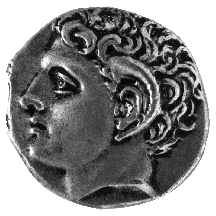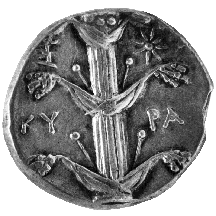



(40) Kyrene, Kyrenaica (Libya) - AR didrachm, early 3rd
c. B.C., 7.74 g. (inv. 91.102).
Obverse: Head of horned Apollo Karneios l.
Reverse: Silphium plant; monogram l., eight-pointed star
r.; ![]()
![]() : of Ptolemaic Kyrene.
: of Ptolemaic Kyrene.
Provenance: Ex Frederick Knobloch collection; Stack's,
1973.
Bibliography: C.M. Kraay, Archaic and Classical Greek
Coins (Berkeley and Los Angeles) 296-299.
Kyrenaica was on a plateau in present-day Libya, settled by Greeks from
the island of Thera about 630 B.C. Its principal city was Kyrene. Ptolemy
I Soter of Egypt acquired the territory in 322 B.C., and it was under Egyptian
control for much of its history (see no. 57).
The obverse of this coin depicts Apollo Karneios, whose cult was brought
to Kyrene by the Greeks and who was the principal deity of the city after
Zeus Ammon. The epithet Karneios is obscure, but probably ultimately derived
from the Greek word for horn, and refers to the horns of this particular
manifestation of Apollo, a herdman or pastoral deity.
The city's wealth depended upon the now-extinct silphium plant, grown only
in Kyrene, which became the regular device for the city's coins. Its stalk
was eaten as a vegetable, and the sap from its stem and root was used as
a seasoning, a perfume, and a contraceptive drug.
K.J.B.



All contents copyright (c) 1996.
Lawrence University
All rights reserved.